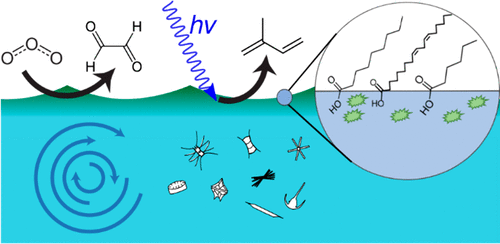当前位置:
X-MOL 学术
›
Acc. Chem. Res.
›
论文详情
Our official English website, www.x-mol.net, welcomes your
feedback! (Note: you will need to create a separate account there.)
Reactive VOC Production from Photochemical and Heterogeneous Reactions Occurring at the Air-Ocean Interface.
Accounts of Chemical Research ( IF 16.4 ) Pub Date : 2020-05-05 , DOI: 10.1021/acs.accounts.0c00095
Gordon A Novak 1 , Timothy H Bertram 1
Accounts of Chemical Research ( IF 16.4 ) Pub Date : 2020-05-05 , DOI: 10.1021/acs.accounts.0c00095
Gordon A Novak 1 , Timothy H Bertram 1
Affiliation

|
ConspectusThe ocean surface serves as a source and sink for a diverse set of reactive trace gases in the atmosphere, including volatile organic compounds (VOCs), reactive halogens, and oxidized and reduced nitrogen compounds. The exchange of reactive trace gases between the atmosphere and ocean has been shown to alter atmospheric oxidant concentrations and drive particle nucleation and growth. Uncertainties in cloud radiative forcing and aerosol-cloud interactions are among the largest uncertainties in current global climate models. Climate models are particularly sensitive to cloud cover over the remote ocean due to large changes in albedo between the ocean surface and cloud tops. Oceanic emissions contribute to cloud condensation nuclei concentrations, either through the direct emission of particles during wave breaking or through the formation of secondary aerosol particles following the emission of reactive gas-phase compounds. Despite generally small and diffuse oceanic emission rates for reactive trace gases, it has been shown that oxidant and particle number concentrations are acutely sensitive to air-sea trace gas exchange rates and the chemical composition of emitted species. To date, field measurements of air-sea reactive gas exchange have focused primarily on the emission of gases of biological origin, such as dimethyl sulfide (DMS). While DMS emissions are relatively well constrained, the gas-phase oxidation that connects DMS to sulfate aerosol is less well understood. Recent laboratory measurements suggest that heterogeneous and photochemical reactions occurring at the air-sea interface can also lead to the production and emission of a wide array of reactive VOC. When laboratory-based measurements are used to derive global scale emissions, the calculated sea-to-air fluxes of reactive VOC generated from heterogeneous and photochemical processes are comparable or larger in magnitude to the sea-to-air flux of DMS. It is not yet clear how the mechanisms proposed in these laboratory experiments translate to atmospheric conditions. The proposed abiotic emissions are also a potential source of VOC in regions of low biological activity, which carries important implications for regional and global modeling.This Account reviews recent laboratory and field experiments of biotic and abiotic ocean VOC emissions, with a specific focus on exploring open questions related to proposed abiotic reactive VOC emissions and the impact of including a large, abiotic VOC emission source on atmospheric oxidants and aerosol particles. To date, abiotic emissions are not typically included in global chemical transport models. The proposed abiotic emissions mechanisms discussed here have the potential to drive significant changes to current understanding of chemistry in the marine atmosphere if present at the magnitudes suggested by laboratory studies. In order to validate their proposed significance, a coordinated set of laboratory, field, and modeling studies under ocean-relevant conditions are necessary.
中文翻译:

空气-海洋界面发生的光化学反应和异构反应产生的挥发性有机化合物。
概述海洋表面是大气中各种反应性痕量气体的源和汇,其中包括挥发性有机化合物(VOC),反应性卤素以及氧化和还原的氮化合物。大气和海洋之间的反应性微量气体的交换已显示出会改变大气中氧化剂的浓度并推动颗粒成核和生长。云辐射强迫和气溶胶-云相互作用的不确定性是当前全球气候模式中最大的不确定性。由于海洋表面和云顶之间的反照率发生较大变化,气候模型对偏远海洋的云层特别敏感。海洋排放导致云凝结核浓度升高,既可以通过在破波过程中直接发射颗粒,也可以通过在发射反应性气相化合物之后形成二次气溶胶颗粒来实现。尽管反应性痕量气体的海洋排放率总体上较小且分散,但已表明氧化剂和颗粒物浓度对空气-海域痕量气体交换速率和排放物质的化学组成极为敏感。迄今为止,空气-海洋反应性气体交换的现场测量主要集中在生物源气体的排放,例如二甲基硫醚(DMS)。尽管DMS的排放受到相对较好的限制,但将DMS连接到硫酸盐气溶胶的气相氧化的了解却很少。最近的实验室测量表明,在海气界面发生的异质和光化学反应也可能导致多种反应性VOC的产生和排放。当使用基于实验室的测量值来得出全球规模的排放量时,由异质和光化学过程产生的反应性VOC的海空通量与DMS的海空通量相当或更大。尚不清楚这些实验室实验中提出的机制如何转化为大气条件。拟议的非生物排放物也是生物活性较低区域的潜在VOC来源,这对区域和全球建模具有重要意义。此帐户回顾了生物和非生物海洋VOC排放物的近期实验室和现场实验,特别着重探讨与拟议的非生物活性VOC排放有关的未解决问题,以及包括大量非生物VOC排放源对大气氧化剂和气溶胶颗粒的影响。迄今为止,非生物排放通常不包括在全球化学品运输模型中。如果实验室研究建议的数量级存在,此处讨论的拟议的非生物排放机制有可能推动对当前对海洋大气化学的理解发生重大变化。为了验证其建议的重要性,必须在海洋相关条件下进行一组协调的实验室,田野和建模研究。大气氧化剂和气溶胶颗粒上的非生物VOC排放源。迄今为止,非生物排放通常不包括在全球化学品运输模型中。如果实验室研究建议的数量级存在,此处讨论的拟议的非生物排放机制有可能推动对当前对海洋大气化学的理解发生重大变化。为了验证其建议的重要性,必须在海洋相关条件下进行一组协调的实验室,田野和建模研究。大气氧化剂和气溶胶颗粒上的非生物VOC排放源。迄今为止,非生物排放通常不包括在全球化学品运输模型中。如果实验室研究建议的数量级存在,此处讨论的拟议的非生物排放机制有可能推动对当前对海洋大气化学的理解发生重大变化。为了验证其建议的重要性,必须在海洋相关条件下进行一组协调的实验室,田野和建模研究。如果实验室研究建议的数量级存在,此处讨论的拟议的非生物排放机制有可能推动对当前对海洋大气化学的理解发生重大变化。为了验证其建议的重要性,必须在海洋相关条件下进行一组协调的实验室,田野和建模研究。如果实验室研究建议的数量级存在,此处讨论的拟议的非生物排放机制有可能推动对当前对海洋大气化学的理解发生重大变化。为了验证其建议的重要性,必须在海洋相关条件下进行一组协调的实验室,田野和建模研究。
更新日期:2020-05-05
中文翻译:

空气-海洋界面发生的光化学反应和异构反应产生的挥发性有机化合物。
概述海洋表面是大气中各种反应性痕量气体的源和汇,其中包括挥发性有机化合物(VOC),反应性卤素以及氧化和还原的氮化合物。大气和海洋之间的反应性微量气体的交换已显示出会改变大气中氧化剂的浓度并推动颗粒成核和生长。云辐射强迫和气溶胶-云相互作用的不确定性是当前全球气候模式中最大的不确定性。由于海洋表面和云顶之间的反照率发生较大变化,气候模型对偏远海洋的云层特别敏感。海洋排放导致云凝结核浓度升高,既可以通过在破波过程中直接发射颗粒,也可以通过在发射反应性气相化合物之后形成二次气溶胶颗粒来实现。尽管反应性痕量气体的海洋排放率总体上较小且分散,但已表明氧化剂和颗粒物浓度对空气-海域痕量气体交换速率和排放物质的化学组成极为敏感。迄今为止,空气-海洋反应性气体交换的现场测量主要集中在生物源气体的排放,例如二甲基硫醚(DMS)。尽管DMS的排放受到相对较好的限制,但将DMS连接到硫酸盐气溶胶的气相氧化的了解却很少。最近的实验室测量表明,在海气界面发生的异质和光化学反应也可能导致多种反应性VOC的产生和排放。当使用基于实验室的测量值来得出全球规模的排放量时,由异质和光化学过程产生的反应性VOC的海空通量与DMS的海空通量相当或更大。尚不清楚这些实验室实验中提出的机制如何转化为大气条件。拟议的非生物排放物也是生物活性较低区域的潜在VOC来源,这对区域和全球建模具有重要意义。此帐户回顾了生物和非生物海洋VOC排放物的近期实验室和现场实验,特别着重探讨与拟议的非生物活性VOC排放有关的未解决问题,以及包括大量非生物VOC排放源对大气氧化剂和气溶胶颗粒的影响。迄今为止,非生物排放通常不包括在全球化学品运输模型中。如果实验室研究建议的数量级存在,此处讨论的拟议的非生物排放机制有可能推动对当前对海洋大气化学的理解发生重大变化。为了验证其建议的重要性,必须在海洋相关条件下进行一组协调的实验室,田野和建模研究。大气氧化剂和气溶胶颗粒上的非生物VOC排放源。迄今为止,非生物排放通常不包括在全球化学品运输模型中。如果实验室研究建议的数量级存在,此处讨论的拟议的非生物排放机制有可能推动对当前对海洋大气化学的理解发生重大变化。为了验证其建议的重要性,必须在海洋相关条件下进行一组协调的实验室,田野和建模研究。大气氧化剂和气溶胶颗粒上的非生物VOC排放源。迄今为止,非生物排放通常不包括在全球化学品运输模型中。如果实验室研究建议的数量级存在,此处讨论的拟议的非生物排放机制有可能推动对当前对海洋大气化学的理解发生重大变化。为了验证其建议的重要性,必须在海洋相关条件下进行一组协调的实验室,田野和建模研究。如果实验室研究建议的数量级存在,此处讨论的拟议的非生物排放机制有可能推动对当前对海洋大气化学的理解发生重大变化。为了验证其建议的重要性,必须在海洋相关条件下进行一组协调的实验室,田野和建模研究。如果实验室研究建议的数量级存在,此处讨论的拟议的非生物排放机制有可能推动对当前对海洋大气化学的理解发生重大变化。为了验证其建议的重要性,必须在海洋相关条件下进行一组协调的实验室,田野和建模研究。

































 京公网安备 11010802027423号
京公网安备 11010802027423号